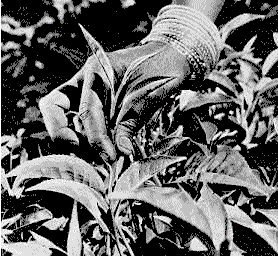| The tea plant, Camellia Sinensis, can be grown almost anywhere. The best teas are grown in cooler climates and/or at higher elevations. Once the tea plant has reached maturity the leaves can be harvested from it for many years. The leaves are harvested, in cooler climates or at higher elevations, four to five times a year. When the plant begins a growth spurt or flush, the picking is started at exactly the right time, to assure that the leaves are large enough, but not too old. Just the top two leaves and the bud are picked for the best black and green teas. Only the buds are picked for some very special teas. There are two major objectives in the processing of tea. The first is to preserve the tea by driving most of the moisture from the leaves. The second objective is to bring flavor out on the surface of the leaves so that it can transfer quickly to the water during the steeping process. After picking, the green leaves are spread out to wither between 12 to 18 hours. During the withering process, the leaves lose most of their moisture, becoming soft and pliable. This allows the leaves to be rolled without tearing. Rolling breaks the membranes of the leaves releasing the natural juices to collect on the surface of the leaf. After rolling, the leaves are brought into large, cool, humid rooms to ferment. The fermentation process produces essential oils from the natural juices. The essential oils give each black tea it’s characteristic aroma and flavor. The fermentation process must be stopped at the point where the aroma and flavor of the tea have fully developed. This is done by firing the leaves in large ovens. The essential oils dry on the surface of the leaves and remain relatively stable until exposed to boiling water during infusion. In the last step of production, the leaves must be sorted by size. During the production process, approximately 80% of tea leaves are broken or crushed so that the finished tea consists of full leaves, broken leaves and smaller particles (fannings) and tea dust. Since the necessary steeping time increases with the size of the leaf, the tea must be sorted into lots of equal leaf size. The large leaves, 20% of the tea, is the best grade, the small broken leaves are the next grade, the fannings and tea dust is used in tea bags. Any regions growth may be manufactured into green, oolong, or black tea. The growing conditions of a particular region may make tea suited to one manufacture over another. |
 |